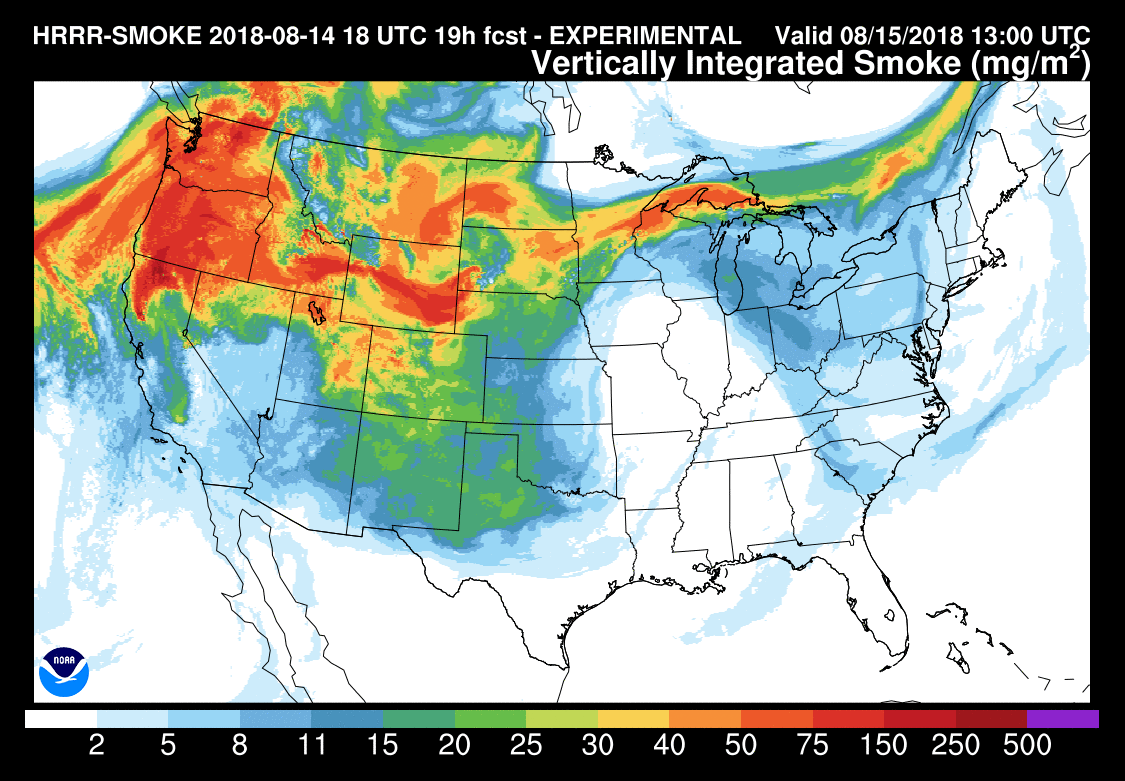By Christian L'Orange
The number and intensity of wildfires in the United States has increased in recent years. An average of ~7 million acres a year have burned since 2000, which is double the rate than between 1990-2000 (1). These wildfires pose great danger to people, wildlife, and structures, but also release harmful pollutants. High temperatures from wildfires and strong winds can result in pollutants being transported, literally, around the world (2). Figure 1 is a good example of how = far that smoke can travel.

Wildfires are the single largest source of smoke emitted into the atmosphere every year (4). Wildfires release gases and particles that can reduce visibility and harm the health of both us and the environment. Exposure to smoke can have both short-term and long-term health effects. Short-term exposure can lead to chest pain, shortness of breath, and eye irritation (5). Long-term exposure has been linked to bronchitis, asthma, and high blood pressure (6,7, 8).
Although it can be challenging to avoid exposure to wildfire smoke completely, you can take a few simple steps to reduce the health risks of smoke exposure and feel better during wildfire season:
- Home Filters: Make sure your home furnace and air conditioning system have a high efficiency particle air (HEPA) filter. Ideally, this HEPA filter should have a MERV rating of at least 13. A MERV rating is a measure of what size particles a filter can capture. The higher the number, the better the filter is at getting rid of small particles. Portable air cleaners with these filters can further improve the air quality in your home (9). Make sure the portable air filter you choose is appropriate for the room size. Bedrooms and living rooms are the best locations for these extra filters.
- Reduce Your Exposure: Although it’s tempting to enjoy the outdoors when the weather is nice, try to limit the amount of time you are exposed to wildfire smoke. This can be as simple as keeping your doors and windows closed (as long as you have clean indoor air) and skipping outdoor activities when air pollution levels are particularly high.
- Personal Air Filter: You can wear a facemask when you are outside. When purchasing these masks, look for a rating of N95 or higher. A simple dust mask or surgical mask is not enough; these masks can’t filter out the extremely small particles coming from wildfires (1). Facemasks need to be properly fitting and should have double straps; they will not work for children or men with beards.
Sources:
- “Wildfire Statics.” Congressional Research Service. November 16 2018. URL: https://fas.org/sgp/crs/misc/IF10244.pdf. Accessed February 08 2019.
- Martin, M. Val, et al. "Smoke injection heights from fires in North America: analysis of 5 years of satellite observations." Atmospheric Chemistry & Physics 10.4 (2010).
- NOAA. High-Resolution Rapid Refresh Model. URL: https://rapidrefresh.noaa.gov/hrrr/HRRRsmoke. Accessed Feb 15, 2019.
- Scott Paper
- “Health Recommendations for Wildfire Smoke.” National Jewish Health. URL: https://www.nationaljewish.org/health-insights/air-pollution-and-healthy-homes/wildfire-smoke. Accessed February 08 2019.
- Cohen, Aaron J., et al. "The global burden of disease due to outdoor air pollution." Journal of Toxicology and Environmental Health, Part A 68.13-14 (2005): 1301-1307.
- Brook, Robert D., et al. "Air pollution and cardiovascular disease: a statement for healthcare professionals from the Expert Panel on Population and Prevention Science of the American Heart Association." Circulation 109.21 (2004): 2655-2671.
- Pope III, C. Arden, et al. "Cardiovascular mortality and long-term exposure to particulate air pollution: epidemiological evidence of general pathophysiological pathways of disease." Circulation 109.1 (2004): 71-77.
- “Guide to Air Cleaners in the Home.” United States Environmental Protection Agency. EPA-402-F-08-004.
- “Masks and N95 Respirators.” US Food and Drug Administration. URL: https://www.fda.gov/MedicalDevices/ProductsandMedicalProcedures/GeneralHospitalDevicesandSupplies/PersonalProtectiveEquipment/ucm055977.htm. Accessed February 08 2019.

